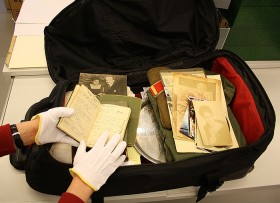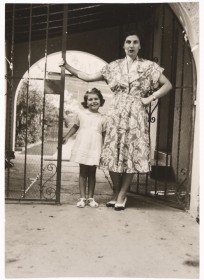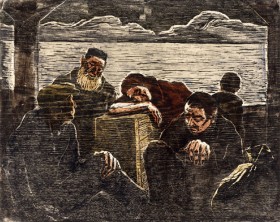The Last Signs of a Life in Germany Sold at Auction 75 Years Ago

Franziska Bogdanov, unpacking the suitcase from Arno Roland’s bequest
Jewish Museum Berlin CC-BY Katharina Erbe
The items in our archives have arrived here through the most various means: we have donations from German-Jewish emigrants from all over the world as well as gifts from their estates, donated to the museum after they have died by their children. We also receive some gifts from Germany, occasionally from people who aren’t themselves Jewish and yet some memorabilia from a Jewish friend or acquaintance was passed down through the generations in their family.
At the end of this last year we received a donation from the estate of a one-time Berliner who recently died in New Jersey (USA). It consisted of a large suitcase filled to the brim with documents, letters, photographs, and other objects. → continue reading
A Look at the Radzewski Family Photo Collection
We all have family: father, mother, children, grandchildren, grandparents, aunts, uncles, or just relatives casually come across at family reunions or known from photos. “The uncle, living abroad, with the daughter and the grandchildren – don’t you remember him?” We’ve all heard that.

The donor, Vera de Jong with her mother, Meta Krotoschiner in front of their home in Santiago, Chile, in 1952, following immigration © Jewish Museum Berlin, gift of Vera de Jong, née Krotoschiner-Radzewski
What happens when there’s no one to keep telling these stories? Only a photo of these people remain, if you’re lucky, sometimes a postcard that says nothing. This isn’t only the case in our private lives. As museum workers, we confront this challenge on a daily basis, especially when inventorying collections of donors’ family photographs. Each photo poses the same questions: Where was this? Who were these people – friends or relatives? What’s the story behind the image?
Fortunately we have help. Along with the photographs, donors provide and entrust us with their memories. Vera de Jong, born Krotoschiner-Radzewski, is one such example. Last year she gave our museum some 200 family photos (further information about the Photographic Collection on our website). As an academic trainee, it was then my task to inventory this collection and research its history. I was immediately taken by these charming images and, while researching them, understood their historical value, helping us uncover more than a century of family history. → continue reading
An Internet Harvest for the Day of the Refugee

“Refugees”, color woodcut by Jakob Steinhardt, 1946, purchased with funds provided by Stiftung DKLB. You can find this and other related objects in our German-language collection database.
This year’s Day of the Refugee takes place today, 2 October 2015 as part of Intercultural Week, with the slogan “Refugees Welcome!” We have taken this as an occasion to go through our own and other websites and blogs, gathering items on this subject. Since we work at a Jewish museum, stories about fleeing are part of our ‘everyday business’: practically all of the family collections given to our museum tell stories of persecution and flight, going beyond mere statistics to depict the fates of individuals. Letters, travel documents, photographs, and personal memorabilia tell of the desperate search for a country to emigrate to, failed or successful emigrations, the often difficult life in a foreign country, the search for relatives, friends, and former neighbors, now scattered across the entire world. We tell these stories in our permanent exhibition and they have also been the subject of various special exhibitions. At the moment, for instance, in our current cabinet exhibition “In a Foreign Country” you can see publications that originated in Jewish Displaced Persons Camps. Jewish men and women waited there for their passage to Palestine or later Israel, to the USA and other countries, where they hoped to start a new life after the Shoah.
In addition to our exhibitions, we also make stories of flight and displacement visible online, for example with a selection of objects: → continue reading


